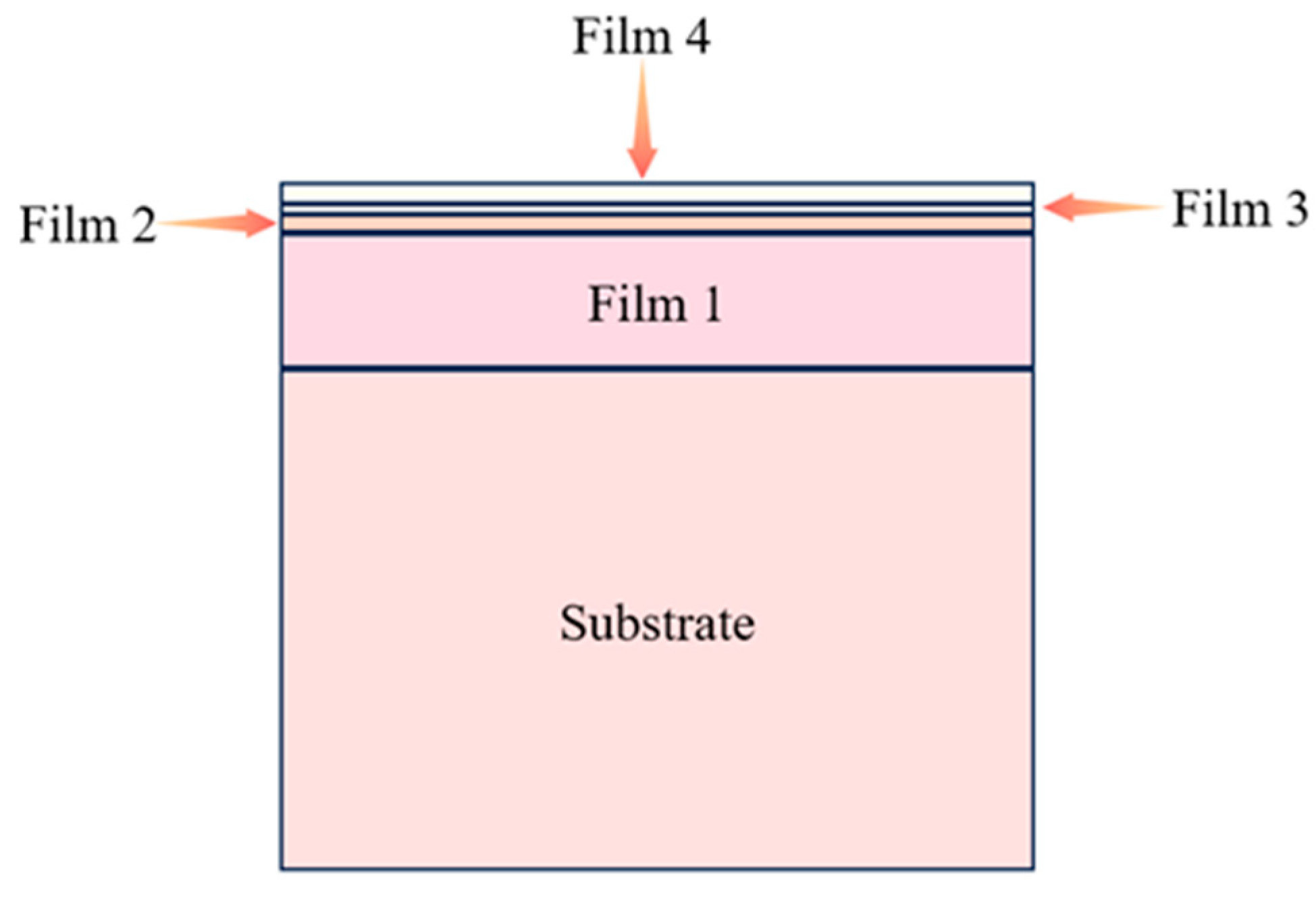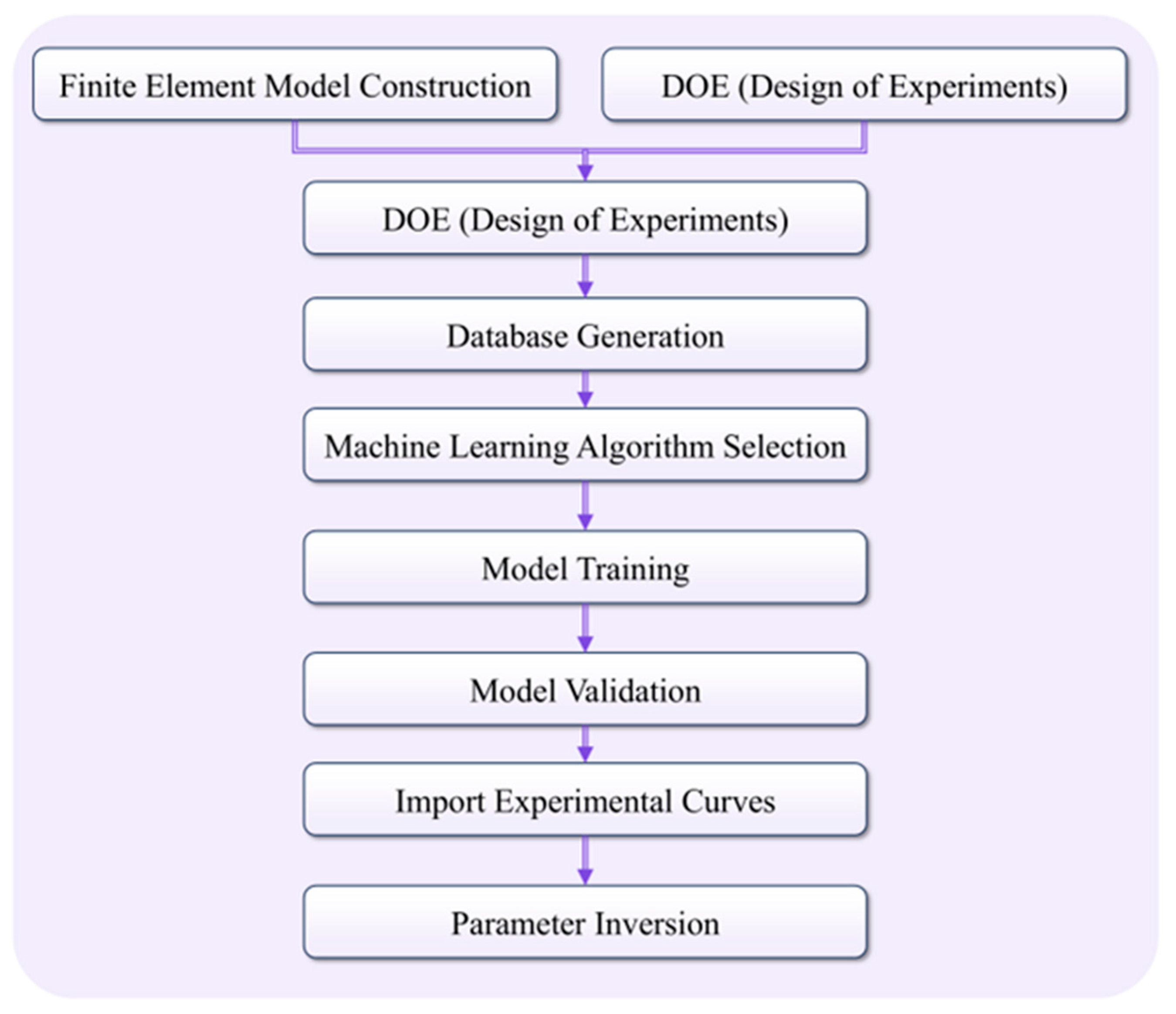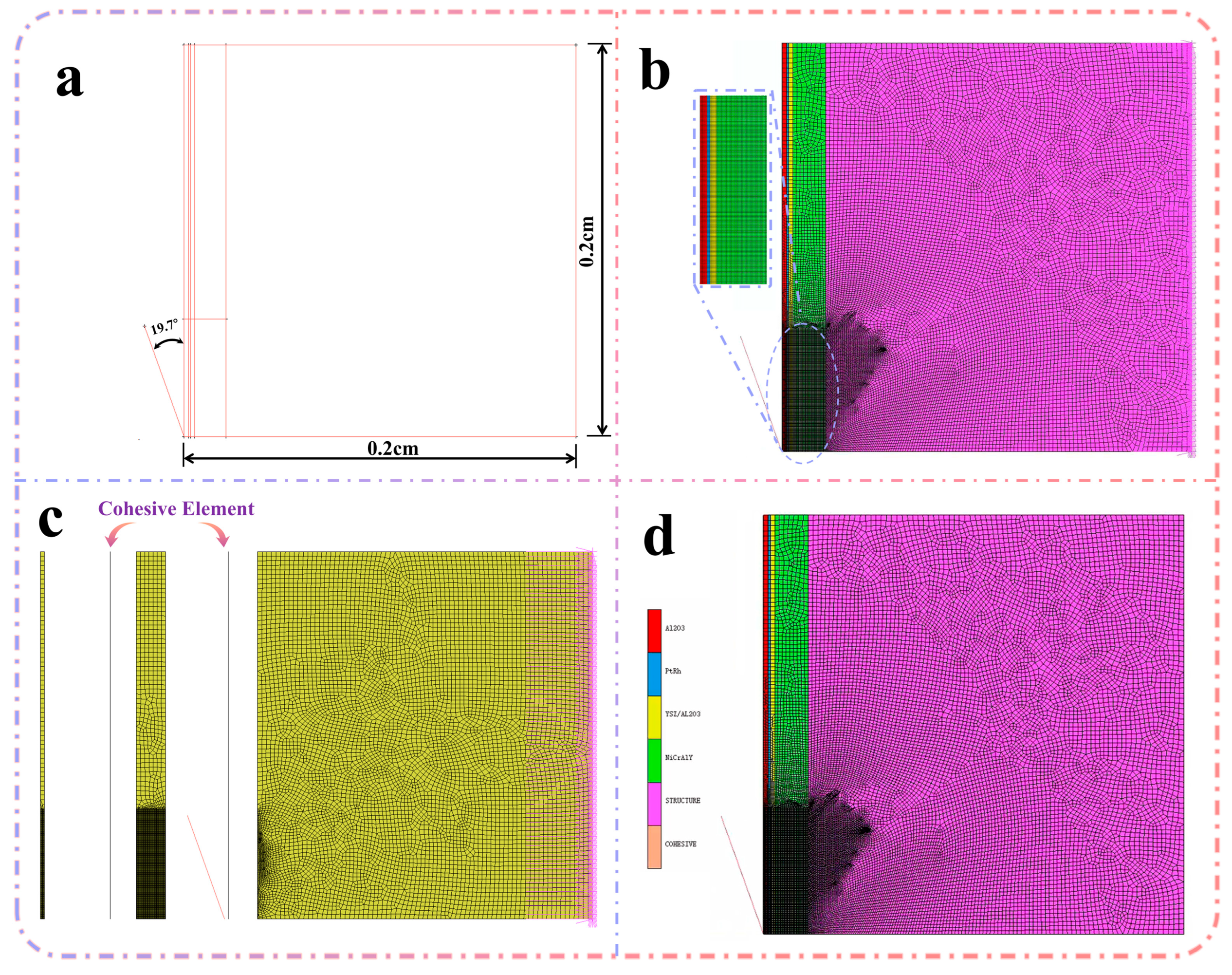Machine Learning Inversion of Layer-Wise Plasticity and Interfacial Cohesive Parameters in Multilayer Thin Films
Abstract
1. Introduction
2. Experimental Methods
2.1. Sample Preparation
2.2. Nanoindentation Test
2.2.1. Experimental Testing Process
2.2.2. Nanoindentation Analysis Method
3. Parameter Back Analysis Method
3.1. Finite Element Modeling
3.1.1. Geometric Modeling and Meshing
3.1.2. Cohesion Model
3.1.3. Von-Mises Yield Criterion
3.2. Machine Learning Methods
3.2.1. Database Generation
3.2.2. Machine Learning Algorithm Selection
3.2.3. Model Reduction Algorithm
3.2.4. Interpolation Methods
3.2.5. Model Validation
3.2.6. Optimization Model
4. Discussion
4.1. Effect of Temperature on Material Parameters and Thermal Stability Analysis
4.2. Efficiency of Back-Analysis
5. Conclusions
Author Contributions
Funding
Informed Consent Statement
Data Availability Statement
Conflicts of Interest
References
- Wang, J.-J.; Wang, T.; Wu, C.-G.; Luo, W.-B.; Shuai, Y.; Zhang, W.-L. Highly Precise Ti/Pt/Cr/Au Thin-Filmtemperature Sensor Embedded in a Microfluidic Device. Rare Met. 2021, 40, 195–201. [Google Scholar] [CrossRef]
- Mishra, D.; Yoon, S.; Seo, Y.; Pak, Y.E. Analytical Solutions of Electroelastic Fields in Piezoelectric Thin-Film Multilayer: Applications to Piezoelectric Sensors and Actuators. Acta Mech. 2020, 231, 1435–1459. [Google Scholar] [CrossRef]
- Wu, C.; Chen, G.-C.; Zhao, F.-X.; Lin, F.; Zeng, Y.-J.; Fu, Y.-Z.; Zhang, Y.-S.; Xu, L.-D.; Chen, Q.-N.; Tang, R.; et al. Innovative Coaxial High-Temperature Thin-Film Sensor with Core–Shell Structure Surpassing Traditional Multilayer Films. Rare Met. 2024, 43, 3854–3867. [Google Scholar] [CrossRef]
- Xue, X.; Wang, S.; Zeng, C.; Li, L.; Wang, Z. Recent Advances in Failure Behavior and Interfacial Energy Testing Methods of Metal Films on Flexible Substrates. Mater. Rev. 2020, 34, 1050–1058. [Google Scholar]
- Huang, X.; Meng, L.; Wei, Q.; Wang, Q.; Zhang, H. Effect of Substrate Structures on the Morphology and Interfacial Bonding Properties of Copper Films Sputtered on Polyester Fabrics. Int. J. Cloth. Sci. Technol. 2017, 29, 39–46. [Google Scholar] [CrossRef]
- Wen, W.; Becker, A.A.; Sun, W. Determination of Material Properties of Thin Films and Coatings Using Indentation Tests: A Review. J. Mater. Sci. 2017, 52, 12553–12573. [Google Scholar] [CrossRef]
- Park, S.; Marimuthu, K.P.; Han, G.; Lee, H. Deep Learning Based Nanoindentation Method for Evaluating Mechanical Properties of Polymers. Int. J. Mech. Sci. 2023, 246, 108162. [Google Scholar] [CrossRef]
- Beake, B.D.; Vishnyakov, V.M.; Harris, A.J. Nano-Scratch Testing of (Ti,Fe)Nx Thin Films on Silicon. Surf. Coat. Technol. 2017, 309, 671–679. [Google Scholar]
- Yang, Q.-S.; Li, S.-W.; Zhu, J.-Q.; Li, X. An Investigation on the Viscoelastic Behavior of Eggshell Membrane by Nanoindentation Technology. Int. J. Appl. Mech. 2019, 11, 1950078. [Google Scholar] [CrossRef]
- Tadayon, K.; Bar-On, B.; Günther, B.; Vogel, C.; Zlotnikov, I. In Situ Nanoindentation at Elevated Humidities. Adv. Mater. Interfaces 2023, 10, 2300459. [Google Scholar] [CrossRef]
- Lloyd, S.; Pitchford, J.; Molina-Aldareguia, J.; Barber, Z.; Blamire, M.; Clegg, W. Nanoindentation in Tin/Nbn Multilayers and Thin Films Examined Using Transmission Electron Microscopy. Microsc. Microanal. 1999, 5, 776–777. [Google Scholar] [CrossRef]
- Wang, Z.; Zhang, M.; Zhao, J.; Zhao, H. Cyclic Nanoindentation of ITO/Ag/ITO Multilayer Films: Hysteresis Behavior and Cyclic Deformation Response. Ceram. Int. 2022, 48, 21054–21059. [Google Scholar] [CrossRef]
- Tang, P.H.; Song, R.G.; Chai, G.Z.; Mao, J. Microstructure and Nanoindentation Hardness of TiN/AlN Multilayer Films Prepared by Pulsed Laser Deposition. Surf. Eng. 2012, 28, 165–170. [Google Scholar] [CrossRef]
- Ma, Z.; Pathegama Gamage, R.; Zhang, C. Application of Nanoindentation Technology in Rocks: A Review. Geomech. Geophys. Geo-Energy Geo-Resour. 2020, 6, 60. [Google Scholar] [CrossRef]
- Kossman, S.; Bigerelle, M. Pop-In Identification in Nanoindentation Curves with Deep Learning Algorithms. Materials 2021, 14, 7027. [Google Scholar] [CrossRef]
- De Bono, D.M.; London, T.; Baker, M.; Whiting, M.J. A Robust Inverse Analysis Method to Estimate the Local Tensile Properties of Heterogeneous Materials from Nano-Indentation Data. Int. J. Mech. Sci. 2017, 123, 162–176. [Google Scholar] [CrossRef]
- Wang, M.; Wu, J.; Hui, Y.; Zhang, Z.; Zhan, X.; Guo, R. Identification of Elastic-Plastic Properties of Metal Materials by Using the Residual Imprint of Spherical Indentation. Mater. Sci. Eng. A 2017, 679, 143–154. [Google Scholar] [CrossRef]
- Wang, M.; Zhang, G.; Hou, B.; Wang, W. Deep Learning Coupled Bayesian Inference Method for Measuring the Elastoplastic Properties of SS400 Steel Welds by Nanoindentation Experiment. Measurement 2025, 242, 116092. [Google Scholar] [CrossRef]
- Amaya-Roncancio, S.; Restrepo-Parra, E. Finite Elements Modeling of Multilayers of Cr/CrN. Microelectron. J. 2008, 39, 1336–1338. [Google Scholar] [CrossRef]
- Sajjad, H.M.; Chudoba, T.; Hartmaier, A. Inverse Method to Determine Parameters for Time-Dependent and Cyclic Plastic Material Behavior from Instrumented Indentation Tests. Materials 2024, 17, 3938. [Google Scholar] [CrossRef]
- Ma, X.; Wang, P.; Li, G.; Zhou, Z. Machine Learning Attacks Resistant Strong PUF Design Utilizing Response Obfuscates Challenge with Lower Hardware Overhead. Microelectron. J. 2023, 142, 105977. [Google Scholar] [CrossRef]
- Li, X.; Liu, Z.; Cui, S.; Luo, C.; Li, C.; Zhuang, Z. Predicting the Effective Mechanical Property of Heterogeneous Materials by Image Based Modeling and Deep Learning. Comput. Methods Appl. Mech. Eng. 2019, 347, 735–753. [Google Scholar] [CrossRef]
- Goodall, R.E.A.; Lee, A.A. Predicting Materials Properties without Crystal Structure: Deep Representation Learning from Stoichiometry. Nat. Commun. 2020, 11, 6280. [Google Scholar] [CrossRef]
- Tiong, L.C.; Lee, G.; Yi, G.H.; Sohn, S.S.; Kim, D. Predicting Failure Progressions of Structural Materials via Deep Learning Based on Void Topology. Acta Mater. 2023, 250, 118862. [Google Scholar] [CrossRef]
- Zhan, W.; Zhang, L.; Feng, X.; Pan, P.; Cai, X.; Wen, X. An Equivalent Processing Method for Integrated Circuit Electrical Parameter Data Using BP Neural Networks. Microelectron. J. 2023, 139, 105912. [Google Scholar] [CrossRef]
- Yang, Y.; Peng, R.; Li, J.; Chen, X.; Zhang, H.; Zhao, J.; He, Y.; Liu, Z. Elastic-Plastic Properties of Ceramic Matrix Composites Characterization by Nanoindentation Testing Coupled with Computer Modeling. Ceram. Int. 2024, 50, 18540–18548. [Google Scholar] [CrossRef]
- Han, G.; Marimuthu, K.P.; Lee, H. Evaluation of Thin Film Material Properties Using a Deep Nanoindentation and ANN. Mater. Des. 2022, 221, 111000. [Google Scholar] [CrossRef]
- Wang, M.; Zhang, G.; Liu, T.; Wang, W. Determination of Elastoplastic Properties of 2024 Aluminum Alloy Using Deep Learning and Instrumented Nanoindentation Experiment. Acta Mech. Solida Sin. 2023, 36, 327–339. [Google Scholar] [CrossRef]
- Zan, X.D.; Guo, X.; Weng, G.J.; Chen, G. Nanoindentation Study of δ-Phase Zirconium Hydride Using the Crystal Plasticity Model. Int. J. Plast. 2023, 167, 103675. [Google Scholar] [CrossRef]
- Zhou, S. Theoretical Evaluation of Elasto-Plastic Nanoindentation Based on Marc. Intell. Manuf. 2023, 209, 209–214. [Google Scholar]
- Qiu, C. Design, Analysis, and Experimental Study of a Micro/Nanoindentation Test Platform under Variable Temperature Environments. Master’s Thesis, Jilin University, Changchun, China, 2013. [Google Scholar]
- Liu, Y. Design, Analysis, and Experimental Study of a Micro/Nanoindentation Test Platform under High Temperature Environments. Master’s Thesis, Jilin University, Changchun, China, 2016. [Google Scholar]
- Gao, W.; Zeng, X.; Wang, D.; Ju, W.; Pan, F. Research on Robustness Analysis Method for Automotive Restraint Systems Based on ODYSSEE. Intell. Manuf. 2023, S01, 110–115.45. [Google Scholar]
- Huang, S.; Zhou, C. Modeling and Simulation of Nanoindentation. JOM 2017, 69, 2256–2263. [Google Scholar] [CrossRef]
- Zhu, D.; Zhao, J.; Hu, Y.; Kan, Q.; Kang, G.; Zhang, X. Predicting Tensile Behavior from Nanoindentation Using Gradient Plasticity Model with Neural Network and Genetic Algorithm. Mech. Mater. 2025, 207, 105368. [Google Scholar] [CrossRef]
- Zhang, T. Micro/Nano-Mechanical Testing Technology: Measurement, Analysis, Application, and Standardization of Instrumented Indentation; Science Press: Beijing, China, 2013. [Google Scholar]
- Jiang, J. Microstructural Testing of Cement-Based Materials and Characteristics of Nanoindentation. Master’s Thesis, Shanghai Jiao Tong University, Shanghai, China, 2020. [Google Scholar]
- Linke, M.; Lammering, R. On the Calibration of the Cohesive Strength for Cohesive Zone Models in Finite Element Analyses. Theor. Appl. Fract. Mech. 2023, 124, 103733. [Google Scholar] [CrossRef]
- Khalfallah, A.; Khalfallah, A.; Benzarti, Z. Identification of Elastoplastic Constitutive Model of GaN Thin Films Using Instrumented Nanoindentation and Machine Learning Technique. Coatings 2024, 14, 683. [Google Scholar] [CrossRef]
- Attaf, M.T. Modeling the Nanoindentation of Elastoplastic Materials with Nonlinear Adaptive Springs (NASs). IEEE Trans. Nanotechnol. 2004, 3, 451–461. [Google Scholar] [CrossRef]
- Kushch, V.I.; Dub, S.N. The Assessment of Elastoplastic Properties of Materials from Nanoindentation and Computer Modeling. 2. Experimental and Theoretical Procedure. J. Superhard Mater. 2012, 34, 215–224. [Google Scholar] [CrossRef]
- Baghani, M.; Fereidoonnezhad, B. Limit Analysis of FGM Circular Plates Subjected to Arbitrary Rotational Symmetric Loads Using Von-Mises Yield Criterion. Acta Mech. 2013, 224, 1601–1608. [Google Scholar] [CrossRef]
- Jin, T.; Zhou, Z.; Qiu, J.; Wang, Z.; Zhao, D.; Shu, X.; Yan, S. Investigation on the Yield Behavior of AZ91 Magnesium Alloy. J. Alloys Compd. 2018, 738, 79–88. [Google Scholar] [CrossRef]
- Wang, Z.; Hao, X.; Qiu, J.; Jin, T.; Shu, X.; Li, X. Anisotropic Yield Criterion of Rolled AZ31 Magnesium Alloy via Nanoindentation. Appl. Sci. 2020, 10, 8997. [Google Scholar] [CrossRef]
- Kang, H.; Tian, Z.; Chen, G.; Li, L.; Wang, T. Application of POD Reduced-Order Algorithm on Data-Driven Modeling of Rod Bundle. Nucl. Eng. Technol. 2022, 54, 36–48. [Google Scholar] [CrossRef]
- Long, X.; Ding, X.; Li, J.; Dong, R.; Su, Y.; Chang, C. Indentation Reverse Algorithm of Mechanical Response for Elastoplastic Coatings Based on LSTM Deep Learning. Materials 2023, 16, 2617. [Google Scholar] [CrossRef]









| Substrate | Film1 (First Layer) | Film2 (Second Layer) | Film3 (Third Layer) | Film4 (Fourth Layer) |
|---|---|---|---|---|
| Al2O3 | NiCrAlY | Al64Zr33Y3 | PtRh | Al2O3 |
| Base | Film1 | Film2 | Film3 | Film4 |
|---|---|---|---|---|
| 0.2 × 0.1787 | 0.2 × 0.016 | 0.2 × 0.002 | 0.2 × 0.001 | 0.2 × 0.0023 |
| Material | Density (kg/m3) | Elasticity Modulus (Gpa) | Specimen Plate |
|---|---|---|---|
| Al2O3 | 3500 | 344.50 | 0.29 |
| Pt-PtRh | 21,450 | 200 | 0.34 |
| Al64Zr33Y3 | 6000 | 174 | 0.37 |
| NiCrAlY | 5000 | 199.90 | 0.30 |
| Base | 8900 | 219 | 0.31 |
| Material | σv (Mpa) | (mJ/mm2) | ∆c (mm) | ∆fail (mm) |
|---|---|---|---|---|
| Al2O3 | 600–800 | 800–1000 | 0.0005–0.001 | 0.005–0.01 |
| Pt-PtRh | 600–800 | 800–1000 | 0.0005–0.001 | 0.005–0.01 |
| Al64Zr33Y3 | 350–550 | 800–1000 | 0.0005–0.001 | 0.005–0.01 |
| NiCrAlY | 500–700 | 800–1000 | 0.0005–0.001 | 0.005–0.01 |
| Base | 500–700 | 800–1000 | 0.0005–0.001 | 0.005–0.01 |
| T (°C) | NiCrAlY (MPa) | Al64Zr33Y3 (MPa) | Base (MPa) | Al2O3 (MPa) | Pt-PtRh (MPa) | GC (mJ/mm2) | ∆c (mm) | ∆fail (mm) |
|---|---|---|---|---|---|---|---|---|
| 25 | 613.075 | 486.158 | 482.274 | 770.375 | 705.088 | 717.162 | 0.000798 | 0.0930 |
| 200 | 613.648 | 494.365 | 493.365 | 779.629 | 705.184 | 965.395 | 0.00858 | 0.0992 |
| 400 | 613.401 | 487.925 | 482.234 | 781.157 | 705.895 | 717.162 | 0.000863 | 0.0960 |
| 600 | 613.118 | 425.897 | 431.802 | 769.704 | 705.255 | 873.987 | 0.000695 | 0.0539 |
| T (°C) | Experiment | Simulation | ||
|---|---|---|---|---|
| H (GPa) | E (GPa) | H (GPa) | E (GPa) | |
| 25 | 2.86 | 125.65 | 2.83 | 113.72 |
| 200 | 2.93 | 135.59 | 3.02 | 135.22 |
| 400 | 3.15 | 138.00 | 2.96 | 146.11 |
| 600 | 2.35 | 189.46 | 2.29 | 207.95 |
| T (°C) | 25 | 200 | 400 | 600 |
|---|---|---|---|---|
| Time (min) | 61 | 72 | 52 | 64 |
Disclaimer/Publisher’s Note: The statements, opinions and data contained in all publications are solely those of the individual author(s) and contributor(s) and not of MDPI and/or the editor(s). MDPI and/or the editor(s) disclaim responsibility for any injury to people or property resulting from any ideas, methods, instructions or products referred to in the content. |
© 2025 by the authors. Licensee MDPI, Basel, Switzerland. This article is an open access article distributed under the terms and conditions of the Creative Commons Attribution (CC BY) license (https://creativecommons.org/licenses/by/4.0/).
Share and Cite
Liu, B.; Liu, S.; Xing, K.; Tan, Z.; Wang, J.; Cao, P. Machine Learning Inversion of Layer-Wise Plasticity and Interfacial Cohesive Parameters in Multilayer Thin Films. Materials 2025, 18, 4976. https://doi.org/10.3390/ma18214976
Liu B, Liu S, Xing K, Tan Z, Wang J, Cao P. Machine Learning Inversion of Layer-Wise Plasticity and Interfacial Cohesive Parameters in Multilayer Thin Films. Materials. 2025; 18(21):4976. https://doi.org/10.3390/ma18214976
Chicago/Turabian StyleLiu, Baorui, Shuyue Liu, Kaiwei Xing, Zhifei Tan, Jianru Wang, and Peng Cao. 2025. "Machine Learning Inversion of Layer-Wise Plasticity and Interfacial Cohesive Parameters in Multilayer Thin Films" Materials 18, no. 21: 4976. https://doi.org/10.3390/ma18214976
APA StyleLiu, B., Liu, S., Xing, K., Tan, Z., Wang, J., & Cao, P. (2025). Machine Learning Inversion of Layer-Wise Plasticity and Interfacial Cohesive Parameters in Multilayer Thin Films. Materials, 18(21), 4976. https://doi.org/10.3390/ma18214976








